Search the Special Collections and Archives Portal
Search Results
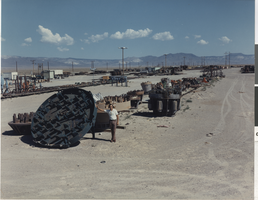
Unidentified man next to hole-drilling equipment: photographic print
Date
1945-19-82
Archival Collection
Description
Unidentified man standing next to big hole drilling equipment at the Nevada Test Site. This the IDECO 2500, a diesel electric rig dwarfs normal oil field gear and is capable of drilling holes up to 120 inches in diameter and 6,000 feet deep.
Image
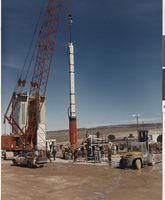
Canister for "Handley" test lowered into hole: photographic print
Date
1970-03
Archival Collection
Description
A nuclear explosive and diagnostic canister for a test named "Handley" is lowered down hole at Pahute Mesa in the Northwestern corner of the Nevada Test Site. Pahute Mesa is used for higher-yield tests because of its remoteness. The Handley test was conducted in March, 1970.
Image
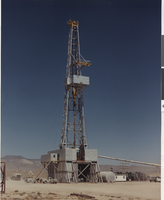
Portrait view of the IDECO 2500: photographic print
Date
1945-19-82
Archival Collection
Description
Another view of the IDECO 2500, a diesel electric rig used to drill holes at the Nevada Test Site (see photograph #0011 in this collection).
Image
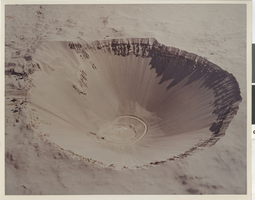
Sedan Crater: photographic print
Date
1967-03-11
Archival Collection
Description
Sedan Crater was formed when a 100 kiloton (KT) explosive was fired at the Nevada Test Site on July 6, 1962, displacing 12 million tons of earth. The crater is 320 feet deep and 1280 feet in diameter.
Image

Two frames of the complete disintegration of a house: photographic print
Date
1945-19-82
Archival Collection
Description
Two views (frames #7 and #8) showing complete disintegration of a house as a result of an explosion at the Nevada Test Site.
Image
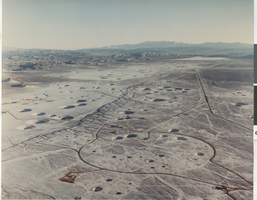
View of the north end of Yucca Flat: photographic print
Date
1945-19-82
Archival Collection
Description
View of the north end of Yucca Flat at the Nevada Test Site. Saucer-shaped craters of varying sizes can be seen. These craters are a result of the detonation of explosives during the testing at the Nevada Test Site.
Image
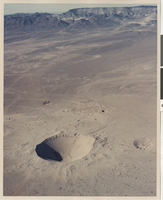
Another view of Sedan Crater: photographic print
Date
1967-03-11
Archival Collection
Description
Another view of Sedan Crater formed July 6, 1962, by a test in the Atomic Energy Commission's Plowshare Program to develop peaceful uses for Nuclear explosives. (See also photo #0014 in this collection).
Image
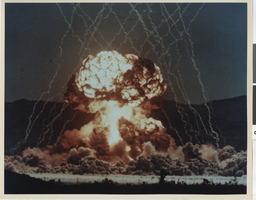
Mushroom cloud of the "Met" nuclear test: photographic print
Date
1959-11-16
Archival Collection
Description
From Operation Teapot, the "Met" test, a tower burst fired April 15, 1955.
Image
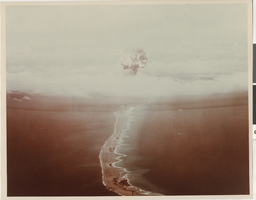
Mushroom cloud of the "George" nuclear test: photographic print
Date
1953-06-24
Archival Collection
Description
The "George" Test of the Greenhouse Series, a weapons related test conducted from a tower on Enewetak (Marshall Islands) on May 8, 1951.
Image
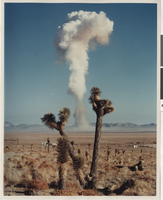
"DeBaca" mushroom cloud: photographic print
Date
1958-10
Archival Collection
Description
A mushroom cloud rises from the desert floor at the Nevada Test Site. The nuclear test, named DeBaca, was a balloon burst fired in October 1958. (All Nuclear Test Site weapons tests have been underground since July 1962.)
Image
Pagination
Refine my results
Content Type
Creator or Contributor
Subject
Archival Collection
Digital Project
Resource Type
Year
Material Type
Place
Language
